ECO mode Peugeot 3008 Hybrid 4 2017 Owner's Manual - RHD (UK. Australia)
[x] Cancel search | Manufacturer: PEUGEOT, Model Year: 2017, Model line: 3008 Hybrid 4, Model: Peugeot 3008 Hybrid 4 2017Pages: 578, PDF Size: 16.41 MB
Page 5 of 578
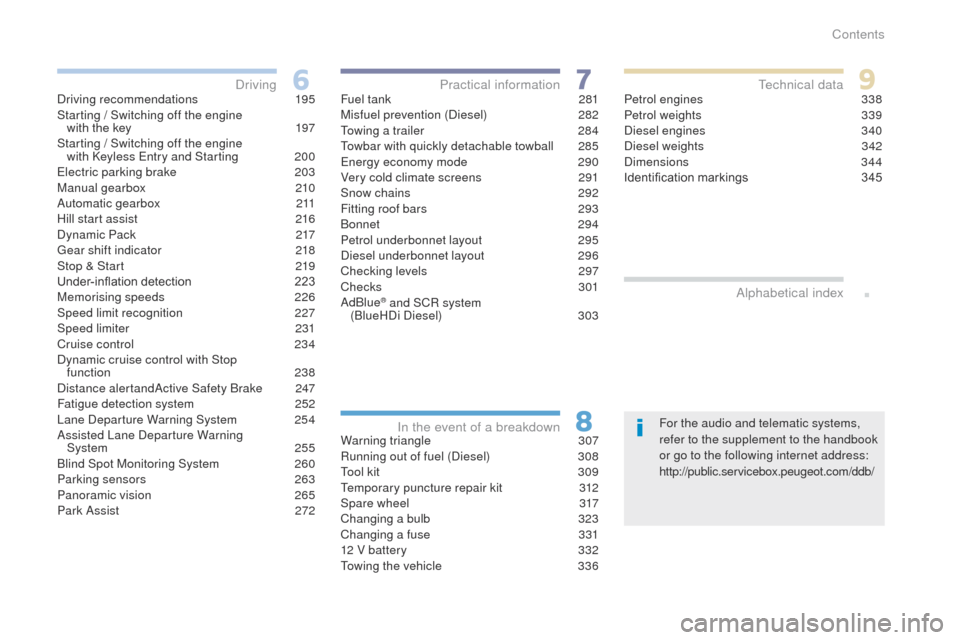
.
3008-2_en_Chap00a_sommaire_ed01-2016
For the audio and telematic systems,
refer to the supplement to the handbook
or go to the following internet address:
http://public.servicebox.peugeot.com/ddb/
Driving recommendations
1
95
Starting / Switching off the engine with the key
1
97
Starting / Switching off the engine with Keyless Entry and Starting
2
00
Electric parking brake
2
03
Manual gearbox
2
10
Automatic gearbox
2
11
Hill start assist
2
16
Dynamic Pack
2
17
Gear shift indicator
2
18
Stop & Start
2
19
Under-inflation detection
2
23
Memorising speeds
2
26
Speed limit recognition
2
27
Speed limiter
23
1
Cruise control
2
34
Dynamic cruise control with Stop function
238
Distance alertandActive Safety Brake
2
47
Fatigue detection system
2
52
Lane Departure Warning System 2
54
Assisted Lane Departure Warning System
25
5
Blind Spot Monitoring System
2
60
Parking sensors
2
63
Panoramic vision
2
65
Park Assist
2
72 Fuel tank
2
81
Misfuel prevention (Diesel)
2
82
Towing a trailer
2
84
Towbar with quickly detachable towball
2
85
Energy economy mode
2
90
Very cold climate screens
2
91
Snow chains
2
92
Fitting roof bars
2
93
Bonnet
294
Petrol underbonnet layout
2
95
Diesel underbonnet layout
2
96
Checking levels
2
97
Checks
301
AdBlue
® and SCR system
(BlueHDi Diesel) 3 03
Warning triangle
3
07
Running out of fuel (Diesel)
3
08
Tool kit
3
09
Temporary puncture repair kit
3
12
Spare wheel
3
17
Changing a bulb
3
23
Changing a fuse
3
31
12 V battery
3
32
Towing the vehicle
3
36Petrol engines
3
38
Petrol weights
3
39
Diesel engines
3
40
Diesel weights
3
42
Dimensions
3
44
Identification markings
3
45
Driving
Practical information
In the event of a breakdown Technical data
Alphabetical index
Contents
Page 11 of 578
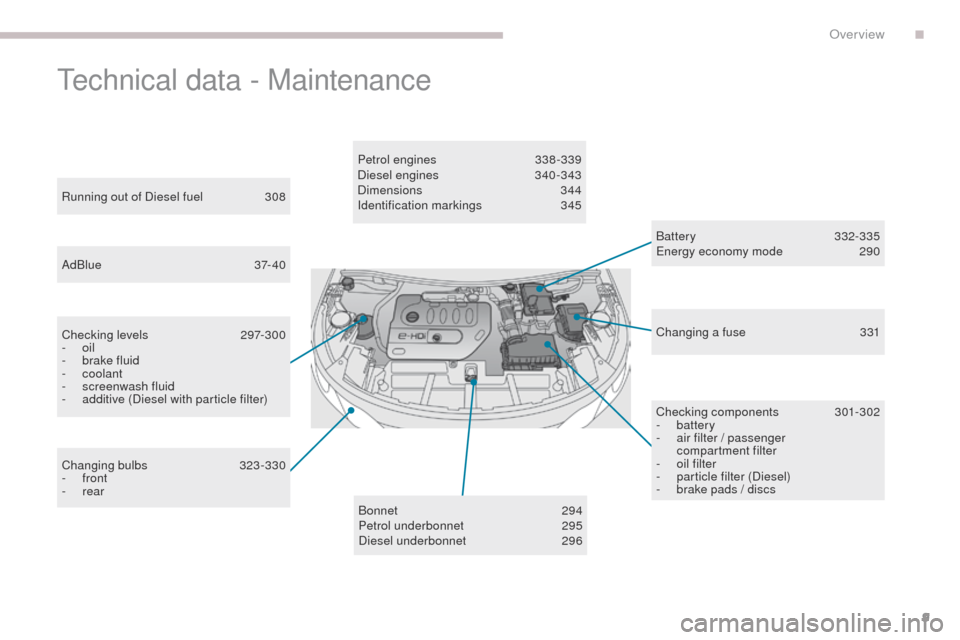
9
3008-2_en_Chap00b_vue-ensemble_ed01-2016
Technical data - Maintenance
Battery 332-335
Energy economy mode 2 90
Running out of Diesel fuel
3
08
AdBlue
3
7- 40
Checking levels
2
97-300
-
oil
-
b
rake fluid
-
coolant
-
s
creenwash fluid
-
a
dditive (Diesel with particle filter) Petrol engines
3
38 -339
Diesel engines
3
40-343
Dimensions
344
Identification markings
3
45
Checking components
3
01-302
-
battery
-
a
ir filter / passenger
compartment filter
-
o
il filter
-
p
article filter (Diesel)
-
b
rake pads / discs
Changing bulbs
3
23-330
-
front
-
rear Changing a fuse
3
31
Bonnet
2
94
Petrol underbonnet
2
95
Diesel underbonnet
2
96
.
Over view
Page 12 of 578
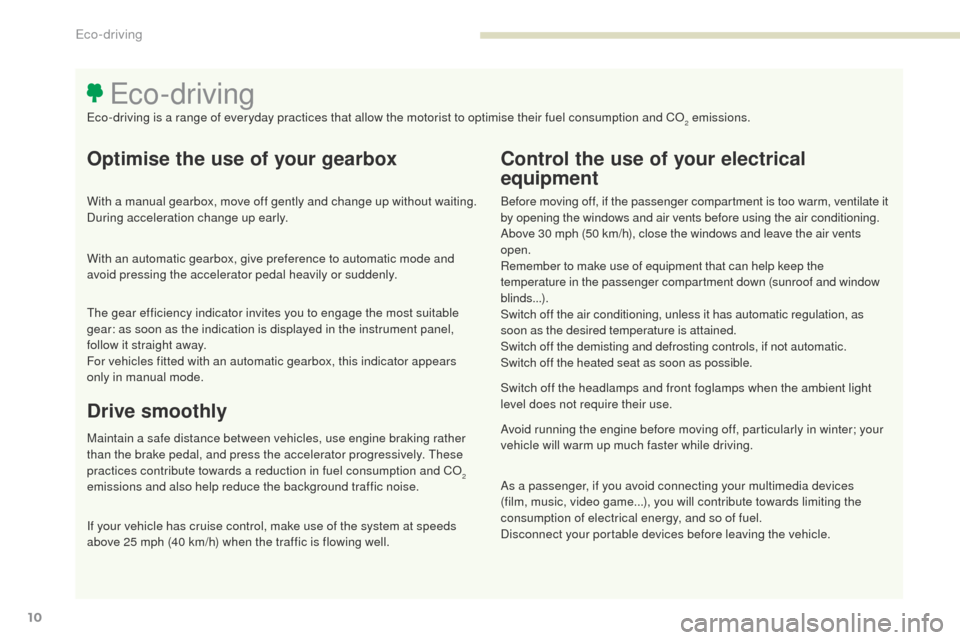
3008-2_en_Chap00c_eco-conduite_ed01-2016
10
Optimise the use of your gearbox
With a manual gearbox, move off gently and change up without waiting.
During acceleration change up early.
With an automatic gearbox, give preference to automatic mode and
avoid pressing the accelerator pedal heavily or suddenly.
Control the use of your electrical
equipment
Before moving off, if the passenger compartment is too warm, ventilate it
by opening the windows and air vents before using the air conditioning.
Above 30 mph (50 km/h), close the windows and leave the air vents
open.
Remember to make use of equipment that can help keep the
temperature in the passenger compartment down (sunroof and window
blinds...).
Switch off the air conditioning, unless it has automatic regulation, as
soon as the desired temperature is attained.
Switch off the demisting and defrosting controls, if not automatic.
Switch off the heated seat as soon as possible.
Switch off the headlamps and front foglamps when the ambient light
level does not require their use.
Avoid running the engine before moving off, particularly in winter; your
vehicle will warm up much faster while driving.
As a passenger, if you avoid connecting your multimedia devices
(film, music, video game...), you will contribute towards limiting the
consumption of electrical energy, and so of fuel.
Disconnect your portable devices before leaving the vehicle.
Eco-driving
Eco-driving is a range of everyday practices that allow the motorist to optimise their fuel consumption and CO2 emissions.
Drive smoothly
Maintain a safe distance between vehicles, use engine braking rather
than the brake pedal, and press the accelerator progressively. These
practices contribute towards a reduction in fuel consumption and CO
2
emissions and also help reduce the background traffic noise.
If your vehicle has cruise control, make use of the system at speeds
above 25 mph (40 km/h) when the traffic is flowing well. The gear efficiency indicator invites you to engage the most suitable
gear: as soon as the indication is displayed in the instrument panel,
follow it straight away.
For vehicles fitted with an automatic gearbox, this indicator appears
only in manual mode.
Eco-driving
Page 14 of 578
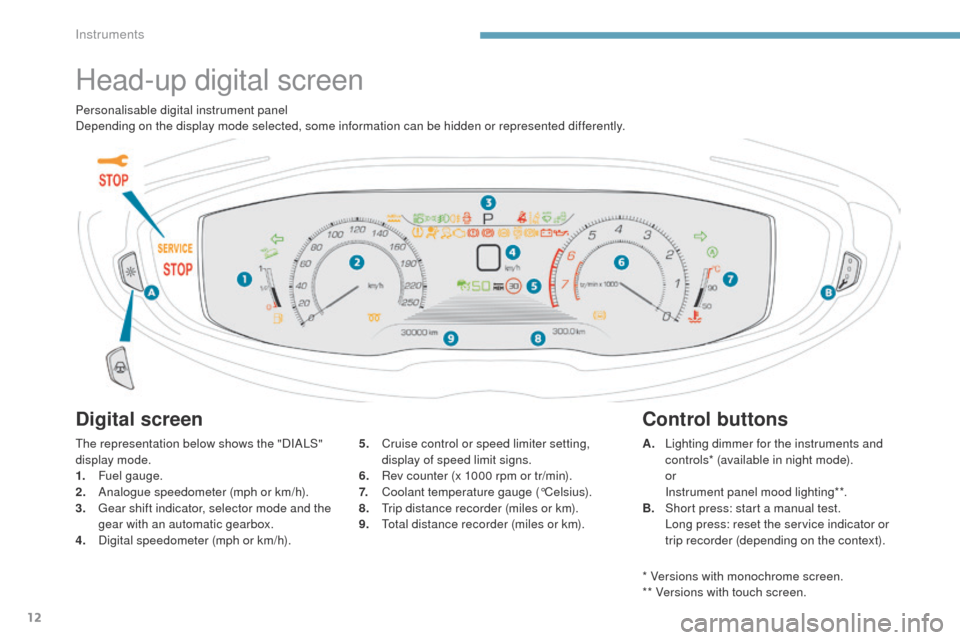
12
3008-2_en_Chap01_instruments-de-bord_ed01-2016
Head-up digital screen
Digital screen
The representation below shows the "DIALS"
display mode.
1.
F
uel gauge.
2.
A
nalogue speedometer (mph or km/h).
3.
G
ear shift indicator, selector mode and the
gear with an automatic gearbox.
4.
D
igital speedometer (mph or km/h). 5. C
ruise control or speed limiter setting,
display of speed limit signs.
6.
R
ev counter (x 1000 rpm or tr/min).
7.
C
oolant temperature gauge (°Celsius).
8.
T
rip distance recorder (miles or km).
9.
T
otal distance recorder (miles or km).
Control buttons
A. Lighting dimmer for the instruments and controls* (available in night mode).
or
I
nstrument panel mood lighting**.
B.
S
hort press: start a manual test.
L
ong press: reset the service indicator or
trip recorder (depending on the context).
Personalisable digital instrument panel
Depending on the display mode selected, some information can be hidden or represented differently.
* Versions with monochrome screen.
** Versions with touch screen.
Instruments
Page 15 of 578
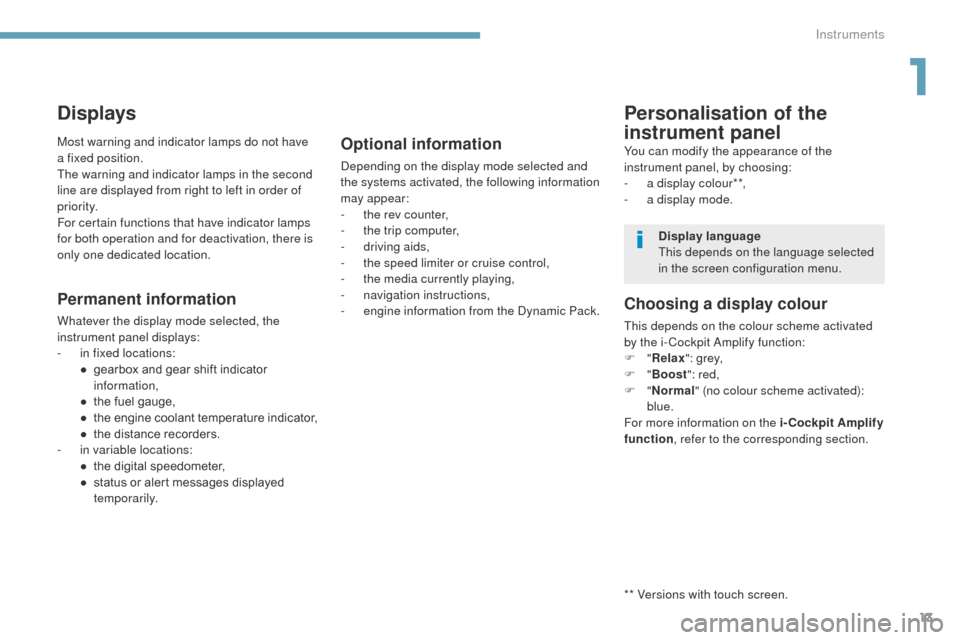
13
3008-2_en_Chap01_instruments-de-bord_ed01-2016
Displays
Permanent information
Whatever the display mode selected, the
instrument panel displays:
-
i
n fixed locations:
●
g
earbox and gear shift indicator
information,
●
t
he fuel gauge,
●
t
he engine coolant temperature indicator,
●
t
he distance recorders.
-
i
n variable locations:
●
t
he digital speedometer,
●
s
tatus or alert messages displayed
temporarily.
Most warning and indicator lamps do not have
a fixed position.
The warning and indicator lamps in the second
line are displayed from right to left in order of
priority.
For certain functions that have indicator lamps
for both operation and for deactivation, there is
only one dedicated location.
Personalisation of the
instrument panel
You can modify the appearance of the
instrument panel, by choosing:
-
a d
isplay colour**,
-
a d
isplay mode.
Display language
This depends on the language selected
in the screen configuration menu.
Choosing a display colour
This depends on the colour scheme activated
by the i- Cockpit Amplify function:
F "Relax ": grey,
F
"Boost ": red,
F
"Normal " (no colour scheme activated):
blue.
For more information on the i-Cockpit Amplify
function , refer to the corresponding section.
** Versions with touch screen.
Optional information
Depending on the display mode selected and
the systems activated, the following information
may appear:
-
t
he rev counter,
-
t
he trip computer,
-
d
riving aids,
-
t
he speed limiter or cruise control,
-
t
he media currently playing,
-
n
avigation instructions,
-
e
ngine information from the Dynamic Pack.
1
Instruments
Page 16 of 578
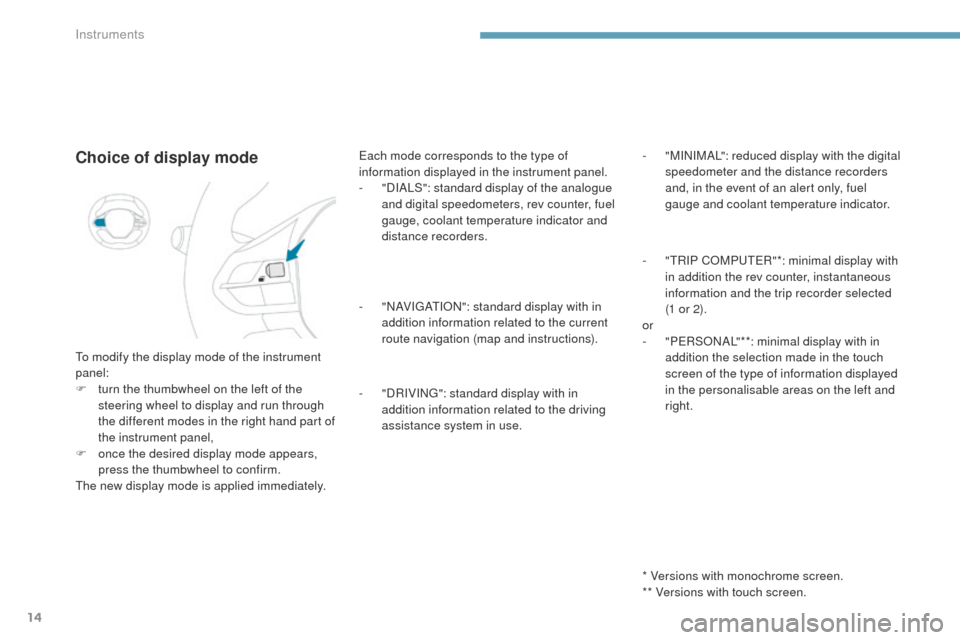
14
3008-2_en_Chap01_instruments-de-bord_ed01-2016
Choice of display mode
To modify the display mode of the instrument
panel:
F
t
urn the thumbwheel on the left of the
steering wheel to display and run through
the different modes in the right hand part of
the instrument panel,
F
o
nce the desired display mode appears,
press the thumbwheel to confirm.
The new display mode is applied immediately. Each mode corresponds to the type of
information displayed in the instrument panel.
-
"
DIALS": standard display of the analogue
and digital speedometers, rev counter, fuel
gauge, coolant temperature indicator and
distance recorders.
-
"
NAVIGATION": standard display with in
addition information related to the current
route navigation (map and instructions).
-
"
DRIVING": standard display with in
addition information related to the driving
assistance system in use.
* Versions with monochrome screen.
** Versions with touch screen. -
"
MINIMAL": reduced display with the digital
speedometer and the distance recorders
and, in the event of an alert only, fuel
gauge and coolant temperature indicator.
-
"
TRIP COMPUTER"*: minimal display with
in addition the rev counter, instantaneous
information and the trip recorder selected
(1 or 2).
or
- " PERSONAL"**: minimal display with in
addition the selection made in the touch
screen of the type of information displayed
in the personalisable areas on the left and
right.
Instruments
Page 18 of 578
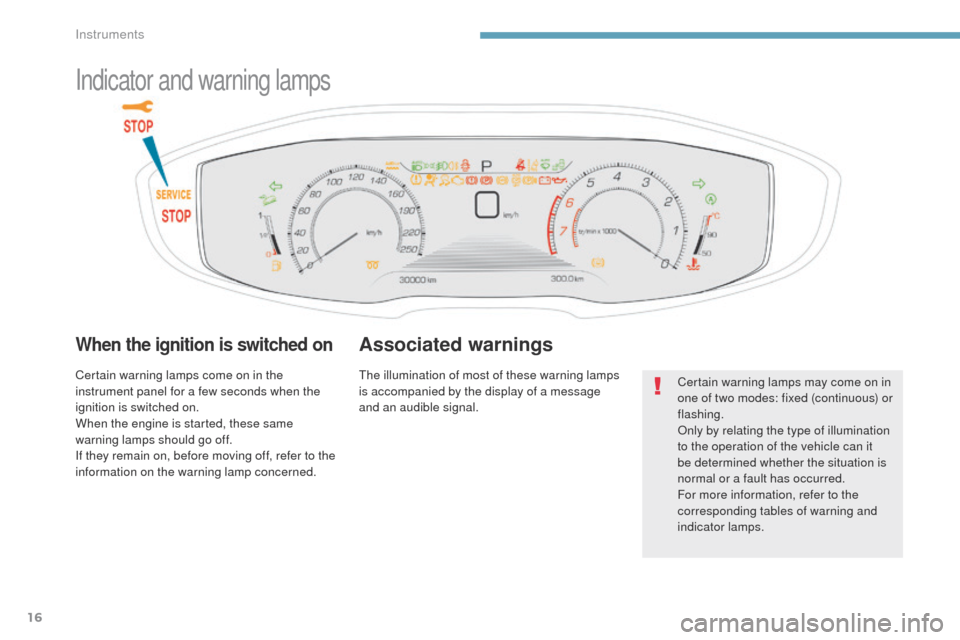
16
3008-2_en_Chap01_instruments-de-bord_ed01-2016
Indicator and warning lamps
When the ignition is switched on
Certain warning lamps come on in the
instrument panel for a few seconds when the
ignition is switched on.
When the engine is started, these same
warning lamps should go off.
If they remain on, before moving off, refer to the
information on the warning lamp concerned.Certain warning lamps may come on in
one of two modes: fixed (continuous) or
flashing.
Only by relating the type of illumination
to the operation of the vehicle can it
be determined whether the situation is
normal or a fault has occurred.
For more information, refer to the
corresponding tables of warning and
indicator lamps.
Associated warnings
The illumination of most of these warning lamps
is accompanied by the display of a message
and an audible signal.
Instruments
Page 20 of 578
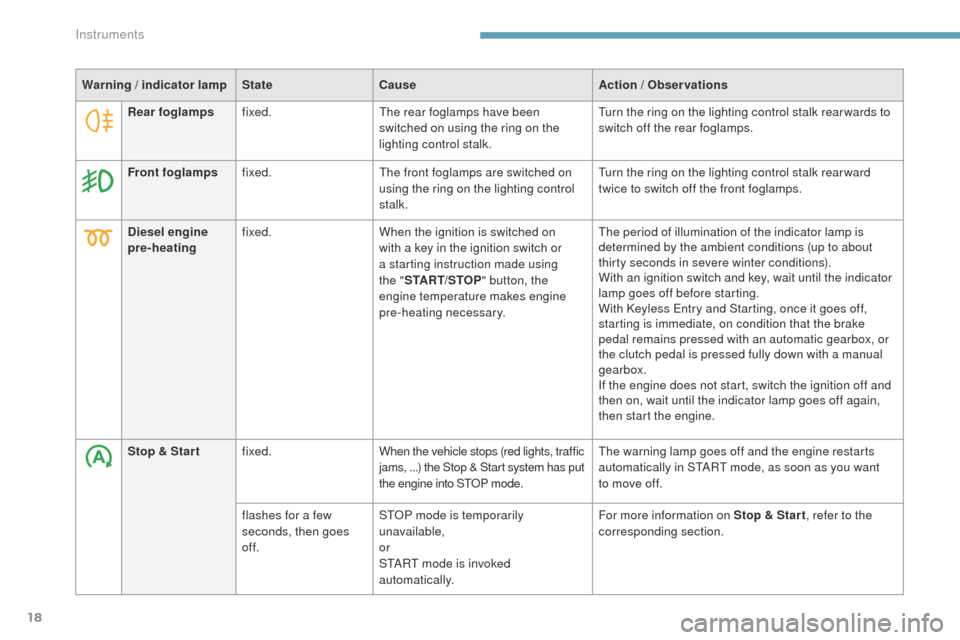
18
3008-2_en_Chap01_instruments-de-bord_ed01-2016
Warning / indicator lampStateCause Action / Observations
Diesel engine
pre-heating fixed.
When the ignition is switched on
with a key in the ignition switch or
a starting instruction made using
the
"START/STOP " button, the
engine temperature makes engine
pre-heating necessary. The period of illumination of the indicator lamp is
determined by the ambient conditions (up to about
thirty seconds in severe winter conditions).
With an ignition switch and key, wait until the indicator
lamp goes off before starting.
With Keyless Entry and Starting, once it goes off,
starting is immediate, on condition that the brake
pedal remains pressed with an automatic gearbox, or
the clutch pedal is pressed fully down with a manual
gearbox.
If the engine does not start, switch the ignition off and
then on, wait until the indicator lamp goes off again,
then start the engine.
Stop & Star t fixed. When the vehicle stops (red lights, traffic
jams,
...) the Stop & Start system has put
the engine into STOP mode. The warning lamp goes off and the engine restarts
automatically in START mode, as soon as you want
to move off.
flashes for a few
seconds, then goes
of f. STOP mode is temporarily
unavailable,
or
START mode is invoked
automatically. For more information on Stop & Star t
, refer to the
corresponding section.
Rear foglamps
fixed. The rear foglamps have been
switched on using the ring on the
lighting control stalk. Turn the ring on the lighting control stalk rear wards to
switch off the rear foglamps.
Front foglamps fixed. The front foglamps are switched on
using the ring on the lighting control
stalk. Turn the ring on the lighting control stalk rear ward
twice to switch off the front foglamps.
Instruments
Page 27 of 578
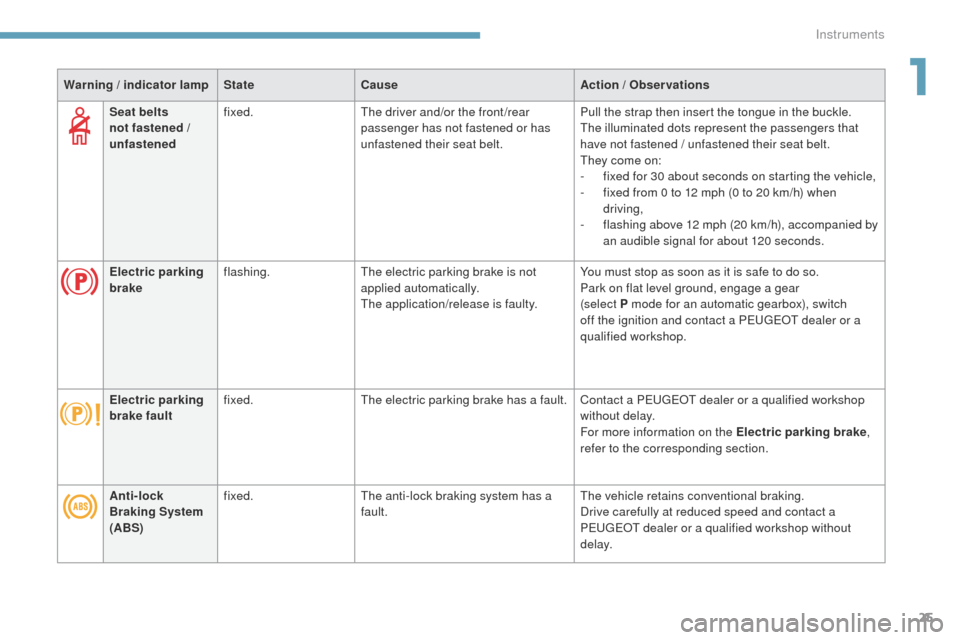
25
3008-2_en_Chap01_instruments-de-bord_ed01-2016
Seat belts
not fastened /
unfastenedfixed.
The driver and/or the front/rear
passenger has not fastened or has
unfastened their seat belt. Pull the strap then insert the tongue in the buckle.
The illuminated dots represent the passengers that
have not fastened / unfastened their seat belt.
They come on:
-
f
ixed for 30 about seconds on starting the vehicle,
-
f
ixed from 0 to 12 mph (0 to 20 km/h) when
driving,
-
f
lashing above 12 mph (20 km/h), accompanied by
an audible signal for about 120 seconds.
Warning / indicator lamp
StateCause Action / Observations
Electric parking
brake flashing.
The electric parking brake is not
applied automatically.
The application/release is faulty. You must stop as soon as it is safe to do so.
Park on flat level ground, engage a gear
(select
P mode for an automatic gearbox), switch
off the ignition and contact a PEUGEOT dealer or a
qualified workshop.
Electric parking
brake fault fixed.
The electric parking brake has a fault. Contact a PEUGEOT dealer or a qualified workshop
without delay.
For more information on the Electric parking brake ,
refer to the corresponding section.
Anti-lock
Braking System
(ABS) fixed.
The anti-lock braking system has a
fault. The vehicle retains conventional braking.
Drive carefully at reduced speed and contact a
PEUGEOT dealer or a qualified workshop without
d e l ay.
1
Instruments
Page 45 of 578
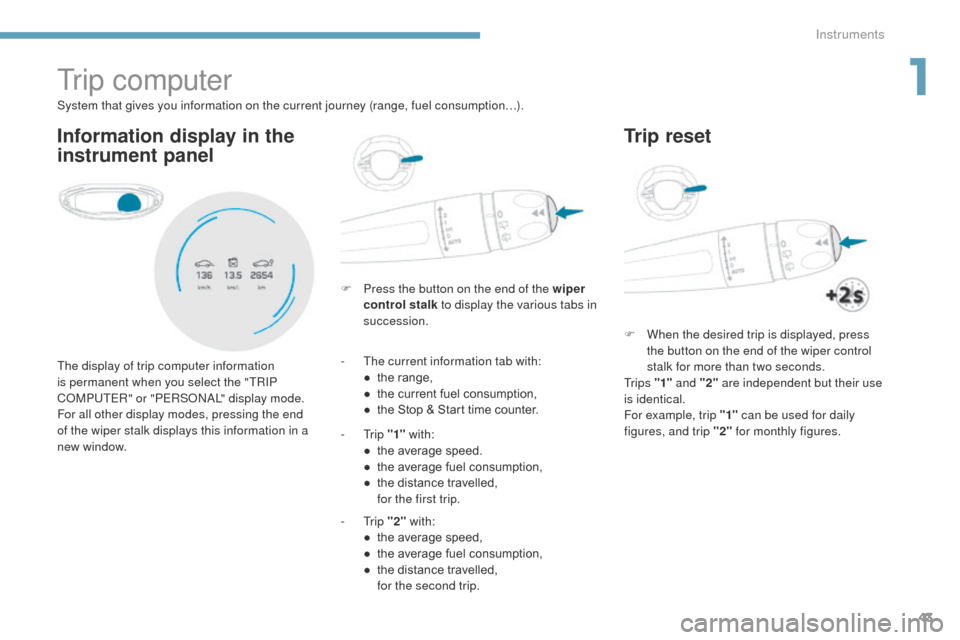
43
3008-2_en_Chap01_instruments-de-bord_ed01-2016
Tr i p c o m p u t e r
Information display in the
instrument panel
F Press the button on the end of the wiper control stalk to display the various tabs in
succession.
The display of trip computer information
is permanent when you select the "TRIP
COMPUTER" or "PERSONAL" display mode.
For all other display modes, pressing the end
of the wiper stalk displays this information in a
new window. System that gives you information on the current journey (range, fuel consumption…).
-
T
he current information tab with:
●
t
he range,
●
t
he current fuel consumption,
●
t
he Stop & Start time counter.
-
Trip "1" with:
●
t
he average speed.
●
t
he average fuel consumption,
●
t
he distance travelled,
f
or the first trip.
-
Trip "2" with:
●
t
he average speed,
●
t
he average fuel consumption,
●
t
he distance travelled,
f
or the second trip.
Trip reset
F When the desired trip is displayed, press the button on the end of the wiper control
stalk for more than two seconds.
Tr i p s "1" and "2" are independent but their use
is identical.
For example, trip "1" can be used for daily
figures, and trip "2" for monthly figures.
1
Instruments